Neural Network Example
Build a 2-hidden layers fully connected neural network (a.k.a multilayer perceptron) with TensorFlow.
This example is using some of TensorFlow higher-level wrappers (tf.estimators, tf.layers, tf.metrics, ...), you can check 'neural_network_raw' example for a raw, and more detailed TensorFlow implementation.
- Author: Aymeric Damien
- Project: https://github.com/aymericdamien/TensorFlow-Examples/
Neural Network Overview
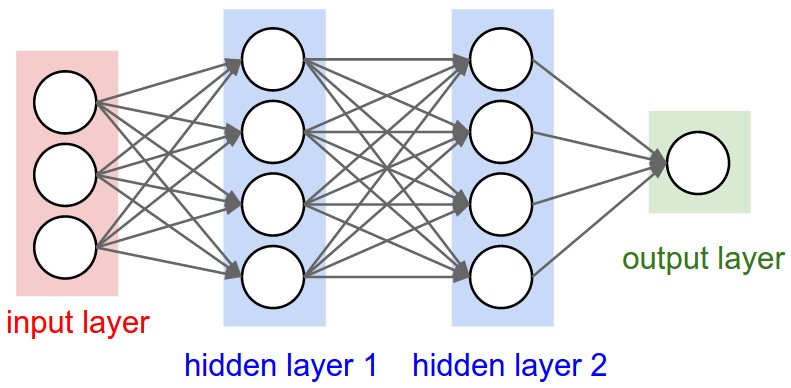
MNIST Dataset Overview
This example is using MNIST handwritten digits. The dataset contains 60,000 examples for training and 10,000 examples for testing. The digits have been size-normalized and centered in a fixed-size image (28x28 pixels) with values from 0 to 1. For simplicity, each image has been flattened and converted to a 1-D numpy array of 784 features (28*28).
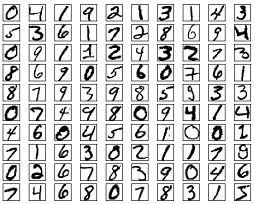
More info: http://yann.lecun.com/exdb/mnist/
from __future__ import print_function
# Import MNIST data
from tensorflow.examples.tutorials.mnist import input_data
mnist = input_data.read_data_sets("/tmp/data/", one_hot=False)
import tensorflow as tf
import matplotlib.pyplot as plt
import numpy as np
Extracting /tmp/data/train-images-idx3-ubyte.gz
Extracting /tmp/data/train-labels-idx1-ubyte.gz
Extracting /tmp/data/t10k-images-idx3-ubyte.gz
Extracting /tmp/data/t10k-labels-idx1-ubyte.gz
# Parameters
learning_rate = 0.1
num_steps = 1000
batch_size = 128
display_step = 100
# Network Parameters
n_hidden_1 = 256 # 1st layer number of neurons
n_hidden_2 = 256 # 2nd layer number of neurons
num_input = 784 # MNIST data input (img shape: 28*28)
num_classes = 10 # MNIST total classes (0-9 digits)
# Define the input function for training
input_fn = tf.estimator.inputs.numpy_input_fn(
x={'images': mnist.train.images}, y=mnist.train.labels,
batch_size=batch_size, num_epochs=None, shuffle=True)
# Define the neural network
def neural_net(x_dict):
# TF Estimator input is a dict, in case of multiple inputs
x = x_dict['images']
# Hidden fully connected layer with 256 neurons
layer_1 = tf.layers.dense(x, n_hidden_1)
# Hidden fully connected layer with 256 neurons
layer_2 = tf.layers.dense(layer_1, n_hidden_2)
# Output fully connected layer with a neuron for each class
out_layer = tf.layers.dense(layer_2, num_classes)
return out_layer
# Define the model function (following TF Estimator Template)
def model_fn(features, labels, mode):
# Build the neural network
logits = neural_net(features)
# Predictions
pred_classes = tf.argmax(logits, axis=1)
pred_probas = tf.nn.softmax(logits)
# If prediction mode, early return
if mode == tf.estimator.ModeKeys.PREDICT:
return tf.estimator.EstimatorSpec(mode, predictions=pred_classes)
# Define loss and optimizer
loss_op = tf.reduce_mean(tf.nn.sparse_softmax_cross_entropy_with_logits(
logits=logits, labels=tf.cast(labels, dtype=tf.int32)))
optimizer = tf.train.GradientDescentOptimizer(learning_rate=learning_rate)
train_op = optimizer.minimize(loss_op, global_step=tf.train.get_global_step())
# Evaluate the accuracy of the model
acc_op = tf.metrics.accuracy(labels=labels, predictions=pred_classes)
# TF Estimators requires to return a EstimatorSpec, that specify
# the different ops for training, evaluating, ...
estim_specs = tf.estimator.EstimatorSpec(
mode=mode,
predictions=pred_classes,
loss=loss_op,
train_op=train_op,
eval_metric_ops={'accuracy': acc_op})
return estim_specs
# Build the Estimator
model = tf.estimator.Estimator(model_fn)
INFO:tensorflow:Using default config.
WARNING:tensorflow:Using temporary folder as model directory: /tmp/tmpu7vjLA
INFO:tensorflow:Using config: {'_save_checkpoints_secs': 600, '_session_config': None, '_keep_checkpoint_max': 5, '_tf_random_seed': 1, '_keep_checkpoint_every_n_hours': 10000, '_log_step_count_steps': 100, '_save_checkpoints_steps': None, '_model_dir': '/tmp/tmpu7vjLA', '_save_summary_steps': 100}
# Train the Model
model.train(input_fn, steps=num_steps)
INFO:tensorflow:Create CheckpointSaverHook.
INFO:tensorflow:Saving checkpoints for 1 into /tmp/tmpu7vjLA/model.ckpt.
INFO:tensorflow:loss = 2.44919, step = 1
INFO:tensorflow:global_step/sec: 602.544
INFO:tensorflow:loss = 0.344767, step = 101 (0.167 sec)
INFO:tensorflow:global_step/sec: 618.839
INFO:tensorflow:loss = 0.277633, step = 201 (0.162 sec)
INFO:tensorflow:global_step/sec: 626.418
INFO:tensorflow:loss = 0.407796, step = 301 (0.160 sec)
INFO:tensorflow:global_step/sec: 624.765
INFO:tensorflow:loss = 0.376889, step = 401 (0.160 sec)
INFO:tensorflow:global_step/sec: 624.091
INFO:tensorflow:loss = 0.319697, step = 501 (0.160 sec)
INFO:tensorflow:global_step/sec: 616.907
INFO:tensorflow:loss = 0.39049, step = 601 (0.162 sec)
INFO:tensorflow:global_step/sec: 623.371
INFO:tensorflow:loss = 0.336831, step = 701 (0.161 sec)
INFO:tensorflow:global_step/sec: 617.429
INFO:tensorflow:loss = 0.312776, step = 801 (0.162 sec)
INFO:tensorflow:global_step/sec: 620.825
INFO:tensorflow:loss = 0.312817, step = 901 (0.161 sec)
INFO:tensorflow:Saving checkpoints for 1000 into /tmp/tmpu7vjLA/model.ckpt.
INFO:tensorflow:Loss for final step: 0.24931.
<tensorflow.python.estimator.estimator.Estimator at 0x7f21ac597690>
# Evaluate the Model
# Define the input function for evaluating
input_fn = tf.estimator.inputs.numpy_input_fn(
x={'images': mnist.test.images}, y=mnist.test.labels,
batch_size=batch_size, shuffle=False)
# Use the Estimator 'evaluate' method
model.evaluate(input_fn)
INFO:tensorflow:Starting evaluation at 2017-08-21-13:57:02
INFO:tensorflow:Restoring parameters from /tmp/tmpu7vjLA/model.ckpt-1000
INFO:tensorflow:Finished evaluation at 2017-08-21-13:57:02
INFO:tensorflow:Saving dict for global step 1000: accuracy = 0.9189, global_step = 1000, loss = 0.286567
{'accuracy': 0.91890001, 'global_step': 1000, 'loss': 0.28656715}
# Predict single images
n_images = 4
# Get images from test set
test_images = mnist.test.images[:n_images]
# Prepare the input data
input_fn = tf.estimator.inputs.numpy_input_fn(
x={'images': test_images}, shuffle=False)
# Use the model to predict the images class
preds = list(model.predict(input_fn))
# Display
for i in range(n_images):
plt.imshow(np.reshape(test_images[i], [28, 28]), cmap='gray')
plt.show()
print("Model prediction:", preds[i])
INFO:tensorflow:Restoring parameters from /tmp/tmpu7vjLA/model.ckpt-1000
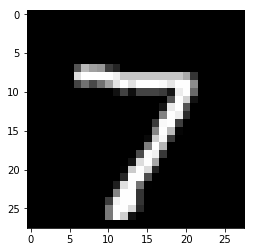
Model prediction: 7
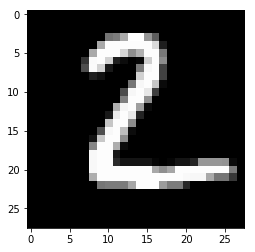
Model prediction: 2
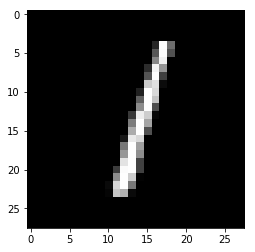
Model prediction: 1
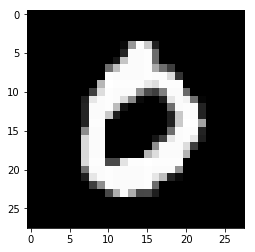
Model prediction: 0